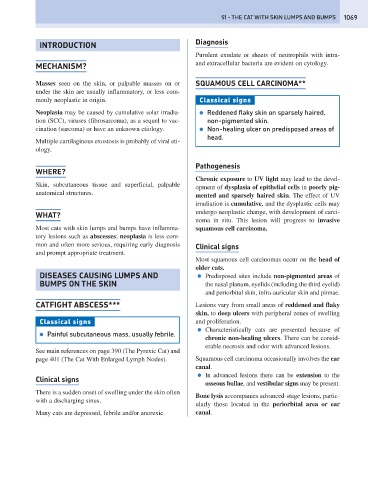Page 1077 - Problem-Based Feline Medicine
P. 1077
51 – THE CAT WITH SKIN LUMPS AND BUMPS 1069
INTRODUCTION Diagnosis
Purulent exudate or sheets of neutrophils with intra-
and extracellular bacteria are evident on cytology.
MECHANISM?
Masses seen on the skin, or palpable masses on or SQUAMOUS CELL CARCINOMA**
under the skin are usually inflammatory, or less com-
monly neoplastic in origin. Classical signs
Neoplasia may be caused by cumulative solar irradia- ● Reddened flaky skin on sparsely haired,
tion (SCC), viruses (fibrosarcoma), as a sequel to vac- non-pigmented skin.
cination (sarcoma) or have an unknown etiology. ● Non-healing ulcer on predisposed areas of
head.
Multiple cartilaginous exostosis is probably of viral eti-
ology.
Pathogenesis
WHERE?
Chronic exposure to UV light may lead to the devel-
Skin, subcutaneous tissue and superficial, palpable
opment of dysplasia of epithelial cells in poorly pig-
anatomical structures.
mented and sparsely haired skin. The effect of UV
irradiation is cumulative, and the dysplastic cells may
undergo neoplastic change, with development of carci-
WHAT?
noma in situ. This lesion will progress to invasive
Most cats with skin lumps and bumps have inflamma- squamous cell carcinoma.
tory lesions such as abscesses; neoplasia is less com-
mon and often more serious, requiring early diagnosis Clinical signs
and prompt appropriate treatment.
Most squamous cell carcinomas occur on the head of
older cats.
DISEASES CAUSING LUMPS AND ● Predisposed sites include non-pigmented areas of
BUMPS ON THE SKIN the nasal planum, eyelids (including the third eyelid)
and periorbital skin, infra-auricular skin and pinnae.
CATFIGHT ABSCESS*** Lesions vary from small areas of reddened and flaky
skin, to deep ulcers with peripheral zones of swelling
Classical signs and proliferation.
● Characteristically cats are presented because of
● Painful subcutaneous mass, usually febrile.
chronic non-healing ulcers. There can be consid-
erable necrosis and odor with advanced lesions.
See main references on page 390 (The Pyrexic Cat) and
page 401 (The Cat With Enlarged Lymph Nodes). Squamous cell carcinoma occasionally involves the ear
canal.
● In advanced lesions there can be extension to the
Clinical signs
osseous bullae, and vestibular signs may be present.
There is a sudden onset of swelling under the skin often
Bone lysis accompanies advanced-stage lesions, partic-
with a discharging sinus.
ularly those located in the periorbital area or ear
Many cats are depressed, febrile and/or anorexic. canal.

